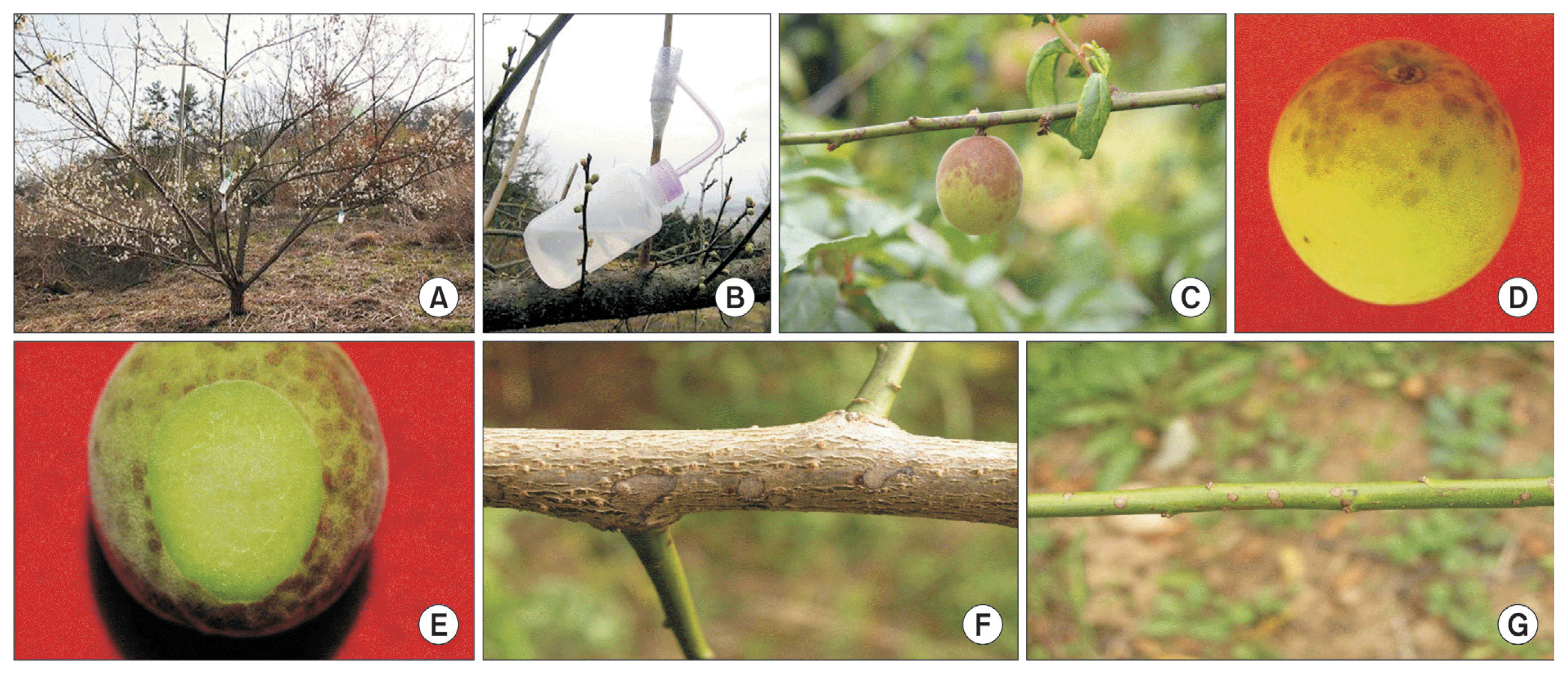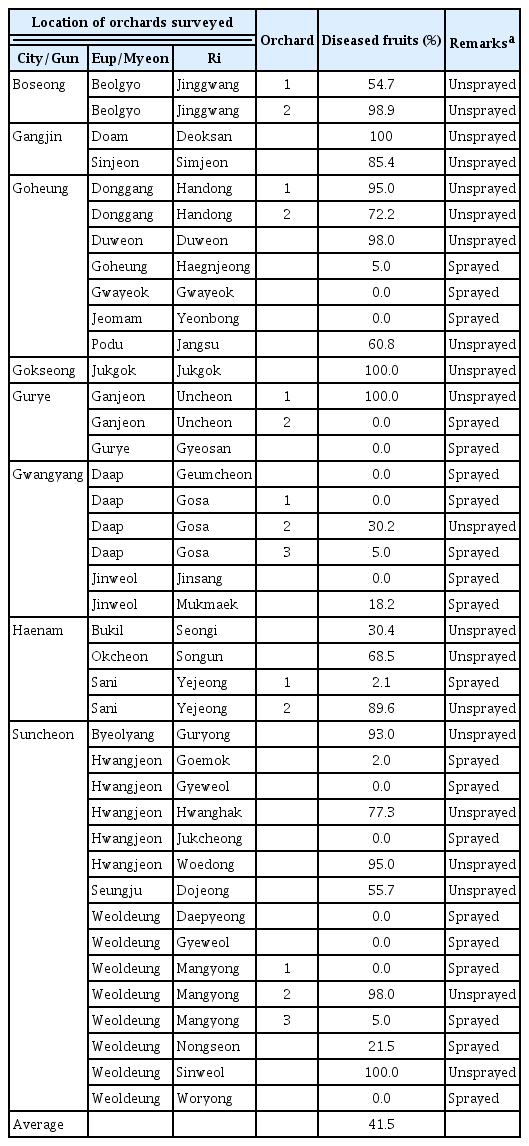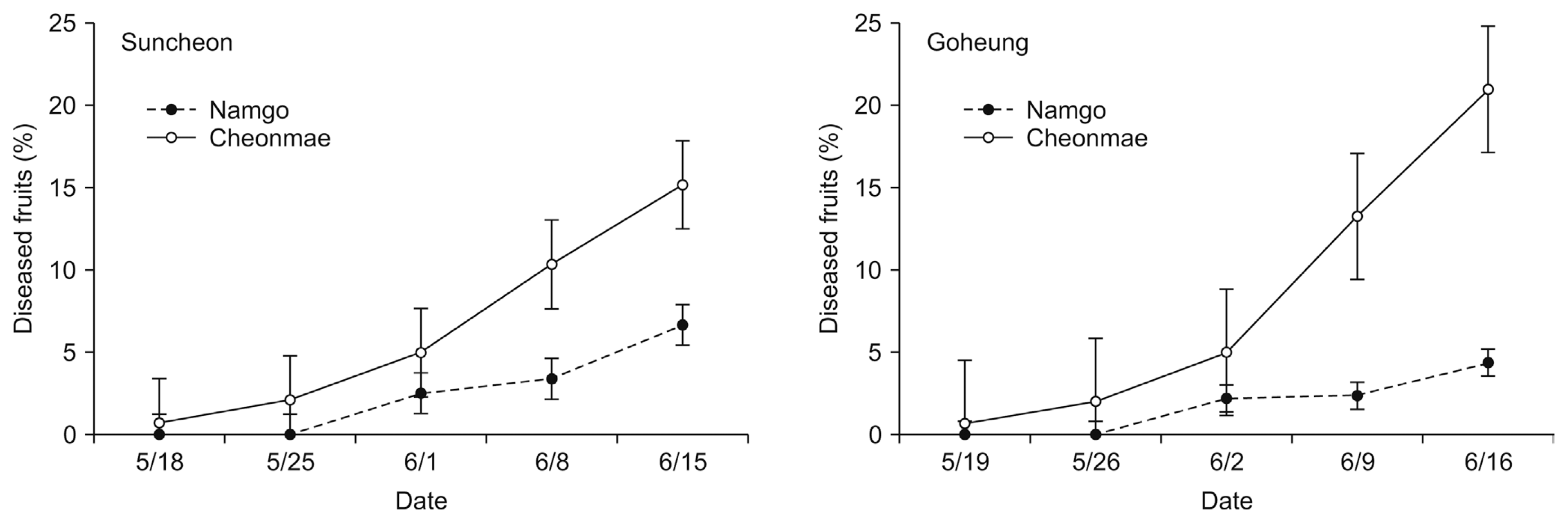Epidemiological Characteristics of Scab of Japanese Apricot in Korea
Article information
Abstract
Scabs caused by Venturia carpophila greatly reduce the quality of the fruits of the Japanese apricot (Prunus mume) when the disease is not properly managed. The disease produces a superficial blemish that is unlikely to affect the overall yield of processed fruit, but reduce the value of fruit intended for the fresh market. Incidence rates of scab at sprayed and unsprayed orchards range from 0% to 21.5% and from 30.2% to 100%, respectively, in the major cultivation regions of Jeonnam Province during the growing season of 2009. The trends in disease progress were quite similar, regardless of regions, and cultivar Namgo was relatively less damaged by scab compared to cultivar Cheonmae among the tested Japanese apricot cultivars. The fruits on branches 1.5 m above the infected Japanese apricot trees and the stem-end parts of the infected fruits were more severely damaged by scabs, possibly because of rain and run-off facilitate dissemination of conidia of V. carpophila and subsequent infection of the fruits or branches. The conidia of V. carpophila were dispersed from March 24 to April 26 in 2010, and more conidia were dispersed from 2-year-old branches than 1-year-old branches. Since the control efficacies were higher than 90% after more than two applications of Trifloxystrobin WG at 10-day-intervals from mid April, it is that effective fungicides be applied at least two times at 10-day-intervals from the middle of April to manage scabs of Japanese apricot in orchards.
Introduction
Japanese apricot (Prunus mume Sieb. Et Zucc.), which originates from central China, is a deciduous fruit-tree belonging to the rose family. The fruit of Japanese apricot has commonly been used as an ingredient in tea, cuisine, and herbal medicine for about 3,000 years in China, Japan, and Korea. In recent years, the fruits of Japanese apricot have been used as a pickles after preservation in soy sauce or pepper paste and their extracts have been used as liquor or juice concentrate (Chuda et al., 1999; Yoon et al., 2005). The fruit-tree is mainly cultivated in the southern coastal regions of Korea because it is very vulnerable to frost and cold injuries.
Several diseases have reportedly impacted Japanese apricot in Korea (The Korean Society of Plant Pathology, 2009). However, these diseases rarely cause serious problems impacting fruit quality because it is usually harvested early, in late May to late June. In recent years, some the incidence of disease has been increasing because of enlargement of the cultivation area and global warming. Among the diseases, bacterial canker and scab are known as the most detrimental diseases reducing the quality of Japanese apricot fruit in orchards (Kim et al., 2005, 2016).
Scab symptoms consist of small, brownish, and circular spots ranging from 1 to 2 mm in diameter at the ends of stems and shoulders of the fruits of Japanese apricot. These spots gradually expand and become brownish-red or black. Multiple spots on the fruits often merge, leading to cracking of the skin. Although the disease produces a blemish, it is superficial and unlikely to effect the overall yield of processing fruit. However, these blemishes reduce the value of fruit intended for the fresh market. In severe cases, up to 100% of the fruit in an orchard can be affected (Kim et al., 2016).
Despite the impact of scabbing, few studies have attempted to elucidate the causal fungus. This is because it is difficult to isolate the causal agent due to its slow growth on artificial media. Recently, the causal agent of scab on Japanese apricot was identified as Venturia carpophila (Kim et al., 2016), but epidemiological characterization of scabs on Japanese apricot have not been conducted in Korea to date. Therefore, this study was carried out to investigate the characteristics of scab epidemics in major areas of Japanese apricot cultivation in Korea and to suggest a proper schedule for application of pesticides to enable efficient control of the disease.
Materials and Methods
Investigation of scab incidence in Japanese apricot orchards
Forty orchards located in major Japanese apricot cultivation areas in Jeonnam Province were randomly selected to investigate scab incidence from June 4 to June 9 in 2009. Twenty orchards had been controlled by spraying with fungicides, whereas the remaining orchards had never been sprayed. The incidence rates of scab in Japanese apricot orchards were measured as the percentages of diseased fruits among 100 randomly selected fruits from each of 10 trees at each orchard.
Investigation of scab incidence according cultivar
Scab incidence on the Japanese apricot cultivars Namgo and Cheonmae was investigated five times at 7-day-intervals in Suncheon from May 18 to June 15, 2010 and in Goheung from May 19 to June 16, 2010. The scab incidence rates on Japanese apricot cultivars were measured as the percentages of diseased fruits among 100 randomly selected fruits from each of 10 trees.
Investigation of scab incidence according branch height
Scab incidence was investigated on fruits from branches at above and below 1.5 m on infected Japanese apricot trees on June 10, 2010. The incidence rates were measured as the percentages of diseased fruits among 100 randomly selected fruits from branches at above and below 1.5 m on the infected 10 Japanese apricot trees. In addition, symptom development progress was investigated on the stem-end and blossom-end parts of the fruits on infected Japanese apricot trees.
Investigation of conidia dispersal at Japanese apricot orchards
Seasonal fluctuations in conidia dispersal of V. carpophila were investigated in Japanese apricot orchards in Suncheon from February 25 to July 5 in 2010, respectively (Fig. 1A). Rainwater collection devices were installed on one-year-old and two-year-old branches of Japanese apricot cultivars Namgo and Cheonmae using the modified rubber plug method described by Umemoto (1990) (Fig. 1B). The conidia (conidia/ml) collected in the devices were enumerated after rain events during the survey periods.

Japanese apricot tree and various scab symptoms. (A) Japanese apricot with rainwater collecting devices. (B) Conidia collecting device. (C) Stem-end part showing numerous scab lesions. (D) Scab symptoms developed on the stem-end part of a fruit attached to an infected branch. (E) Unaffected pulp in the severely infected fruit. (F) Infected 2-year-old branch. (G) Infected 1-year-old branch.
Collecting weather data
To analyze seasonal fluctuations in conidia dispersal of V. carpophila in Japanese apricot orchards according to weather conditions, rainfall and temperature data pertaining to the survey periods in 2010 were obtained from Suncheon Weather Station.
Investigation of fungicide application schedule efficiency
The chemical fungicide Trifloxystrobin WG (5g/20L, DongbuHannong Co.), which is registered as a treatment for Japanese apricot, was used to investigate control efficacies against scab at two naturally infected orchards in 2009 and 2010 according to spray schedules. The fungicide was applied 1–3 times at 10-day-intervals from April 5 in Japanese apricot orchards in Suncheon and Gwangyang in 2009 and from April 15 at Japanese apricot orchards in Suncheon in 2010. A completely randomized design was applied with three replicates and five trees of the Japanese apricot cultivar Cheomae included in each plot. The incidence rates of scab were measured as the average percentages of diseased fruits among 100 randomly selected fruits from each tree on June 1, 2009 and June 2 and 4, 2010. Control values of the fungicide against scab were calculated based on the incidence rates obtained from the sprayed and unsprayed plots.
Results and Discussion
Scab incidence in Japanese apricot orchards
Overall, the average incidence rates of scabs on Japanese apricot were 41.5% at the 40 randomly selected orchards located in major Japanese apricot cultivation regions in Jeonnam Province, Korea in 2009. However, the incidence rates varied from 0% to 100%. The orchards were divided into two categories based on treatment of fungicides, regardless of the types of fungicides and their application times. Among the orchards, the incidence rates at the 20 sprayed orchards ranged from zero to 21.5%, but the incidence rates at the 20 unsprayed orchards ranged from 30.2% to 100% (Table 1). These findings indicate that it is likely that scab disease can fatally affect the fruit quality of Japanese apricot, unless the disease is properly managed by treatment with effective fungicides.
Scab incidence rates according cultivar
Scab symptoms on the Japanese apricot cultivars Namgo and Cheonmae were first observed around the middle of May in 2010 in Suncheon and Goheung, respectively, but the incidence rates were less than 1% until late May, after which they rapidly increased. The incidence rates on the Japanese apricot cultivars Namgo and Cheonmae were 6.7% and 15.2% in Suncheon and 4.4% and 21.0% in Goheung when the final measurements were taken on June 15 and 16, respectively (Fig. 2). The disease progress curves on the cultivars were quite similar in Goheung and Suncheon, but the Namgo cultivar showed less damage than the Cheonmae cultivar. These results suggest that there may be great differences in the resistance or susceptibility to scabs among cultivars commonly grown in Korea. Therefore, it is recommended that Namgo or other resistant cultivars be grown at orchards in which V. carpophila is prevalent (Kim et al., 2014).
Scab incidence rates according branch height
The average scab incidence rates of fruits on the branches at above 1.5 m were 38.0%, while they were less than 5% at below 1.5 m (Table 2). Japanese apricot trees are trained to prevent them from becoming tall to facilitate pruning and harvest. Since the shape of Japanese apricot trees is similar to an umbrella or bowl, the fruits on the branches at above 1.5 m are open to rainfall. Therefore, rain may help disseminate the conidia of V. carpophila and infect the fruits on the branches. Conversely, the fruits on the branches at below 1.5 m may escape colonization by V. carpophila because of the reduced chance of contact with rain.

Scab incidence rates on the fruits on branches at above and below 1.5 m on infected Japanese apricot trees
Scab symptoms began to appear on the stem-end parts of infected Japanese apricot fruits in the early infection stage, after which they developed toward the blossom-end parts (Fig. 1C). While numerous black spots colonized by the conidia of V. carpophila covered the entire surface of the severely infected fruits (Fig. 1D), light infection resulted in small black specks around the stem-end parts, but no lesions on the blossom-end of the fruits. Scab symptom development on the fruits appeared to be influenced by rainfall, as observed on the infected Japanese apricot trees. This was likely because the stem-end parts open to rainfalls had a greater chance to become wet than the blossom-end parts of the fruits. A similar phenomenon has been observed on Satsuma mandarin and yuzu infected by Diaporthe citri (Agostini et al., 2003; Gopal et al., 2014; Hur and Park, 2005; Kwon et al., 2003; Sasaki, 1965). Infected areas on the fruits were scattered or aggregated, or in tear-streaks, depending on where water transported the inoculums prior to infection. Although scabs created severe fruit skin blemishes, the fungus does not normally affect the pulp (Fig. 1E). However, scab outbreaks result in economic losses since the disease causes external blemishes that reduce the value of fruit intended for the fresh market.
Conidia dispersal at Japanese apricot orchards
Although we tried to capture conidia from rainwater collection devices during several rainfall events before mid March, we did not capture any conidia of V. carpohila until March 24, 2010. Thereafter, conidia were captured until April 26, but their amounts were not as high as on March 24 (Fig. 3).

Maximum and mean temperatures and rainfall in Suncheon, Jeonnam Province and the number of dispersed conidia collected using the rainwater collection device after rainfall events at Seo-myeon in Suncheon during the 2010 growing season.
It is assumed that conidia might begin to be dispersed when the maximum temperatures were higher than 20°C in mid March since the optimum temperature ranges for the growth of V. carpophila are reportedly 20–27°C (Rural Agriculture Association Japan, 2005). Interestingly, the conidia of V. carpophila were mainly captured from 2-year-old branches (Fig. 1F), and not from 1-year-old branches (Fig. 1G) on March 24. These results correspond to the finding that the scab lesions on the 2-year-old branches produced more conidia than those on other branches on Japanese apricot trees in Japan (Rural Agriculture Association Japan, 2005). These findings indicate that winter pruning of diseased 2-year-old branches is necessary to alleviate scabbing.
The amount of conidia of V. carpophila captured from cultivar Cheonmae was more than 2-fold higher than that obtained from cultivar Namgo on March 24. These results are closely related to the finding that scab severities of cultivar Cheonmae were much higher than those of cultivar Namgo (Fig. 2). This means that cultivar Cheonmae is more susceptible than cultivar Namgo to scab, since pathogens could more easily infect and colonize susceptible host plants rather than the resistant ones (Agrios, 2005). Overall, we inferred that it may be possible to utilize resistant cultivars to manage scabs from these findings, since breeding of resistant cultivars is a promising management strategy for scabs of Japanese apricot. A new cultivar Okjoo was recently developed for Japanese apricot growers, which exerts highly resistant levels to scab and bacterial shot hole diseases (Kim et al., 2014).
Conidia were no longer captured during May to June, although there were heavy rainfall events from mid May to late May and the daily maximum temperatures were almost always higher than 20°C. These findings suggest that conidia might be produced from the lesions on the diseased branches of Japanese apricot trees within about one month from late March to late April. Therefore, protective fungicides should be applied during the infection periods to enable efficient chemical control of scabs at Japanese apricot orchards.
Scab symptoms were first observed on May 18, after which the disease progressed rapidly until harvest. It took 55 days from when the conidia were first captured on March 24 until symptoms first appeared on May 18. These results correspond to the findings that the latent period of scabbing on Japanese apricot is approximately 42–77 days (Rural Agriculture Association Japan, 2005). It is likely that V. carpophila has a long latent period between colonization of Japanese apricot fruits and expression of visual symptoms on the skins of the infected fruits.
Efficient fungicide application schedules
In 2009, one-time application of Trifloxystrobin WG on April 5 showed control efficacies of 57.7% and 63.4% in Suncheon and Gwangyang, respectively. However, two applications of the fungicide at a 10-day interval from April 5 showed control efficacies of 92.6% and 91.8% in Suncheon and Gwangyang, respectively, while three applications at a 10-day interval from April 5 led to 100% control of scabbing in both regions (Table 3).

Control efficacies of Trifloxystrobin WG against scabs on Japanese apricot according to different application schedules at two orchards in Suncheon and Gwangyang, Jeonnam Province, Korea during the growing season of 2009
In 2010, one application of Trifloxystrobin WG on April 15 led to control efficacies of 77.4% and 68.4% of Haeryong and Hwangjeon in Suncheon, while two applications at a 10-day interval led to control efficacies of 98.7% and 96.7%, respectively, and three applications at a 10-day interval starting April 15 led to 100% control in both regions (Table 4). The control efficacies showed similar tendencies in both years, with somewhat higher efficacy in 2010 than 2009, although overall incidence rates were higher in 2009 than 2010. Overall, these findings indicate that spraying from mid-April is better than from early April to control scabbing on Japanese apricot.

Control efficacies of Trifloxystrobin WG against scabs on Japanese apricot according to different application schedules at two orchards in Suncheon, Jeonnam Province, Korea during the growing season of 2010
As shown in the survey results, the average incidence rates of scab on Japanese apricot were 2.9% and 80.1% in the sprayed and unsprayed orchards, respectively, indicating that application of fungicide was very effective at controlling scabbing of Japanese apricot. The control efficacies were above 90% after two or more applications of fungicide at 10-dayintervals from early or mid-April in both years. Huang et al. (1993) reported that the period when the fruits are young, within 1 month of flowering, was most important for infection and most suitable for application of fungicides in Taiwan. Similar results were also reported in Japan (Rural Agriculture Association Japan, 2005). Since the flowering period of Japanese apricot is around mid-March in Korea, it is recommended that effective fungicides be applied at least two times at 10-day-intervals from mid-April to manage scabs of Japanese apricot in orchards. However, fungicide application schedules should be adjusted to match flowering periods at different orchards.
Acknowledgments
This study was carried out with the support of the “Cooperative Research Program for Agricultural Science & Technology Development (Project No. 200803A0108200602)”, RDA, Republic of Korea.

